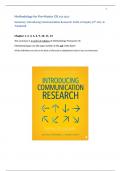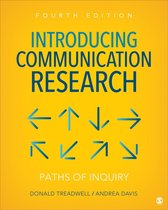1
Methodology for Pre-Master CIS (Fall 2022)
Summary; Introducing Communication Research: Paths of Inquiry (4th ed.), D.
Treadwell.
Chapter 1, 2, 3, 4, 6, 9, 10, 11, 13
This summary is in order of syllabus of Methodology Premaster CIS
Mentioned pages are the page number of the pdf of the book!
All the definitions are also in the back of the book on alphabetical order if you are interested.
, 2
Chapter 1. Getting started: Possibilities and Decisions
This chapter will help you
Identify basic assumptions behind human communication research.
Identify research questions that might be asked about communication.
Describe some of the decisions required when planning communication research.
Any research project requires that you start by getting yourself oriented toward an area of
interest. And then decide what questions, assumptions and methods will answer your
question.
Every research question has assumptions behind it that reflect the researcher’s view of
communication.
Basic assumptions behind communication research:
Consciously or implicitly, researchers bring these assumptions to their research. Several
major assumptions are outlined below.
Observation capture/ do not capture an underlying reality.
no one has ever actually seen an attitude, but the behaving in a particular way for example.
We research attitudes on the assumption that they exist, or at least that it provides a useful
tool for thinking about communication processes.
Theories about human behaviour can/ cannot be generalized
If our world is full of unique individuals, we are not entitled to make any generalizations
about them. Nonetheless, researchers using survey or experimental methods typically will
want to assume that the results of their research will apply to people who are similar to the
study participants assumption that people are similar.
Researches should/ should not distance themselves from their research participants.
The more distant the observer becomes, the more neutral or dispassionate she can be, but
she will be unable to get deeper insights. But moving closer will make her open to
influencing the group dynamics or becoming biased.
Research should/ should not be done for a specific purpose
There is/ is not one best position from which to observe human behaviour
Some aspects of a question are more important to look at than others and there is one best
standpoint from which to observe human communication.
Some aspects of a question are more important to look at than others and, related, that there is one
best standpoint from which to observe human communication. A simple way to understand this is to
consider an early telecommunications-based model of communication (Shannon & Weaver, 1949).
Given the complexities of human communication, it is an overly simplistic model, but it does identify
major components in any human interaction as follows:
, 3
Source—the provider or initiator of content
Message or messages—the content of communication
Channel or medium—the vehicle for communication content; for example, social media
Receiver(s)—the recipient(s) or consumer(s) of information
Noise—extraneous information or distractions that can disrupt an interaction
Context—the relationships between individuals, the situation in which the interaction occurs,
and the cultural norms around that interaction.
Page 53; Looking at how researches approach an advertisement. You see that there are many
possible approaches to studying such communication content.
Globally:
A situation let to many research questions advertisement for driving without texting making
ads does the ad work? (receivers of the message) scientific approach what can readers and
viewers tell us? opinions of audience what can the content tell us? (message content) many
angles from which to study media content (including rhetoric, content analysis, and critical theory)
what can the creators of the ad tell us? (source of the message) how/ why decisions about
content/ production were made.
Communication researchers have different agendas and assumptions that underpin the methods
they use. Because of the complexity of human communication, researchers focus on a part of that
totality.
Researches have to make choices, based on their theoretical resources.
The field of study – wide or narrow?
The researcher – Dispassionate or involved?
Dispassionate vs involved quantitated vs qualitied research.
The approach – Objective or subjective?
The perspective – Your questions or their answers?
The sample – Large or small?
Quantitative researcher mostly interested in larger samples. Qualitative researches more interested
in details, so go for smaller sample sizes.
The data – Quantitative or qualitative?
The report – subjective or objective?
Chapter Summary
This chapter introduced the ways scholars think about communication research, their main areas of
research, and the methods they use. In summary:
Communication research is a process of posing questions about human communication and
designing and implementing research that will answer those questions.
Communication researchers typically specialize in one aspect of communication.
Researchers may use qualitative methods, quantitative methods, or both.
Researchers have empirical, interpretive, or critical perspectives on communication.
Human communication research inescapably involves ethical decisions.
Chapter 2: First Decisions; From inspiration to implementation
, 4
This chapter will help you
Define the terms induction, deduction, and abduction.
Identify key reasons for doing research.
Explain the ways we “know what we know.”
Describe major worldviews in human communication research and how each shapes the
nature of research.
Discuss the advantages and disadvantages of basing your work on the work of other
researchers.
Explain with examples the difference between a research question and a hypothesis.
Let’s start with the basic beliefs and perspectives that shape our thinking about human behaviour
and therefore how we might research it.
Worldview I sees human behaviour as predictable, measurable and generalizable nomothetic
approach. Worldview II sees it as individualistic, unpredictable and subjective idiographic
approach. Research based on this, attempts to describe the individuality of human communication,
rather than aiming to discover universal laws.
Between the two extremes, there are more nuanced views of human communication and how to
research it. For example, Cresswell and Creswell (2018) identify four worldviews:
1. Postpositive no absolute truth, but emphasizes cause and effect and the idea that he
world is governed by laws or theories that can be tested.
2. Constructivist this worldview is that individuals seek understanding of their world and
construct their own views of it. Researchers rely on participant’s own, subjective views of the
world.
3. Transformative change oriented and argues for mixing research with politics, to confront
social oppression and positively change lives.
4. Pragmatism a focus on the problem rather than the research method. And using all
possible approaches to understanding these problems.
To further fine-tune your ideas, consider Craig’s (1999) communication metatheory—a family of
concepts embracing several different traditions of communication research. (page 83).
1. Rhetorical
2. Semiotic
3. Phenomenological
4. Cybernetic
5. Sociopsychological
6. Sociocultural
7. Critical
The relationship between theory and observations
A theory is weak if not supported by evidence, so researchers move between theory and
observation. Three thought processes that link observations with theories are induction, deduction
and abduction.
Induction reasoning from observations to a theory, that might explain your observations. Specific
to general.





